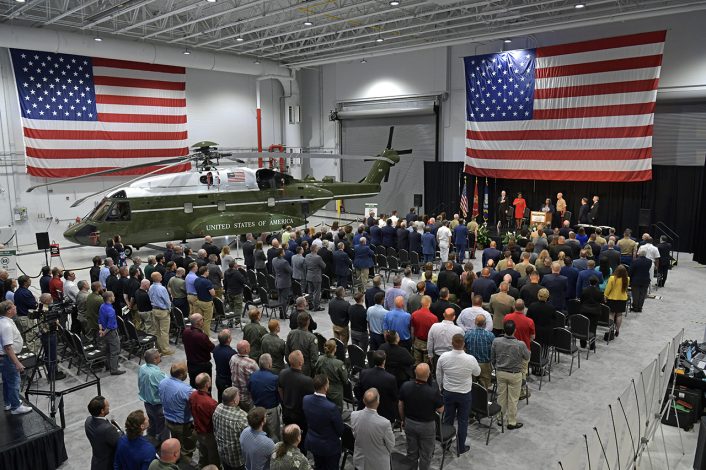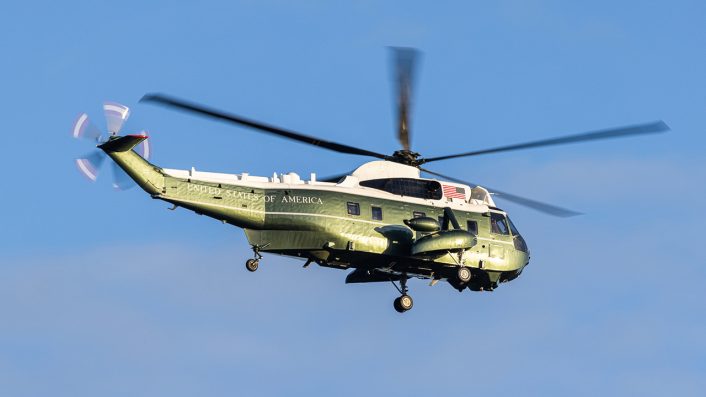U.S. President Joe Biden has used the Sikorsky VH-92A Patriot as Marine One for the first time, just after the last of 23 VH-92A airframes were delivered to the U.S. Marine Corps.
Sikorsky’s VH-92A Patriot helicopter, based on the Sikorsky S-92 platform, has had a long and somewhat troubled entry to service with Marine Helicopter Squadron One, commonly known as HMX-1. The long awaited replacement for the venerable Sikorsky VH-3D Sea Kings and VH-60N White Hawks first flew in 2017 and were first seen on trial flights at the White House in 2018.
Initial Operating Capability (IOC) for the VH-92A was declared in December 2021, though a series of reports detailed continuing issues with the aircraft which restricted its deployment in the VIP transport role. Concerns over the aircraft’s availability, maintenance requirements, and reliability in emergency situations delayed the full entry to service. The VH-92A was also noted to have caused scorch marks on the White House lawn and other grass landing sites, restricting most of the helicopter’s operations to paved surfaces.
While it is not known whether all issues have been rectified completely, it is clear that the airframe has now been judged as suitable to begin operating as the primary Presidential helicopter. President Biden boarded the VH-92A (serial number 169186) on the tarmac at Chicago O’Hare International Airport on Aug. 19, 2024 after stepping off Air Force One, before flying to Soldier Field where he then made a short motorcade journey to the Democratic National Convention at the United Center.
The new Marine One lands at Soldier Field pic.twitter.com/6fDW2H31r8
— Jennifer Epstein (@jeneps) August 19, 2024
The replacement of the VH-3D
Aug. 14 saw the U.S. Marine Corps take delivery of their 23rd and final VH-92A from Sikorsky. 21 of these aircraft will serve in the operational fleet, while two will be designated as test airframes. They will replace the current operational fleet of 10 VH-3D Sea Kings and 6 VH-60N White Hawks. Until 2021, a one-of-a-kind NVH-3A Sea King also supported the fleet as a test airframe, painted in the all-over green used by HMX-1 support helicopters rather than the famous green and white seen on the airframes used as Marine One. It is unclear whether the VH-92As designated as test airframes will be differentiated in the same way.
The long development and test cycle of the VH-92 has meant the service life of HMX-1’s mainstay VH-3D Sea Kings has now stretched across five decades, with the first D model airframe entering service in 1978. The airframes themselves, having been converted from regular Sea Kings, are several years older. They replaced earlier model VH-3A Sea Kings and VH-34 Choctaws, dating from 1962 and 1957 respectively.

VH-60N White Hawks, based on the ubiquitous Sikorsky H-60 design, entered service in 1988. These helicopters are smaller than the Sea Kings, though their folding main rotor blades make them more easy to transport by air. The VH-3Ds must have their rotor blades removed for transport on board C-17 Globemaster III cargo aircraft, and the C-17 must have a minimal fuel load during the onload/offload process to ensure maximum clearance for the helicopter on the aircraft’s rear ramp.
Being larger again than the VH-3D, it is likely similar constraints will apply to the VH-92A. Some of the new helicopters have been deployed on a number of Presidential trips as backup aircraft for the primary fleet, and one such deployment across the Atlantic gave us a first look at how the aircraft will be air transported. As with the VH-3D, the main rotor blades must be removed.
With the strong heat haze yesterday, it was worth a post of this! Today a brand new VH-92 Patriot helicopter belonging to the US Marine Helicopter Squadron (HMX-1) is seen here being onloaded onto the back of a USAF C-17 for President Biden’s upcoming France visit.#POTUS #VH92 pic.twitter.com/HiXjJqXrux
— Callum Dargavel 🏴📷 (@CallumDar21) June 2, 2024
Original plans in the 2000s were to see the legacy types replaced by the VH-71 Kestrel, a development of the AW101 Merlin helicopter backed by Lockheed Martin, which had initially beaten Sikorsky’s S-92 in the VXX Presidential Helicopter Replacement Program. Rising costs during the global financial crisis saw the Kestrel canceled in 2009. Nine airframes had already been completed, which were subsequently sold to Canada to support their existing Merlin fleet.
In the restarted VXX program that began in 2012, Sikorsky were the only manufacturer to submit a bid, leading to the S-92 being crowned as the winner in 2014. A year later, Lockheed Martin, who were part of the VH-71 Kestrel program, acquired Sikorsky for $9 billion.
It is not currently clear how long the transition process from the VH-3D and VH-60N legacy platforms to the VH-92A will take, but the older airframes will likely soldier on for a little while longer while the Patriot settles into service.










